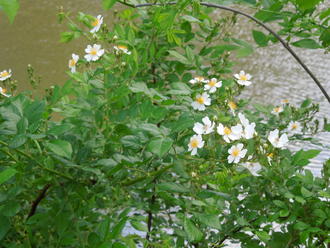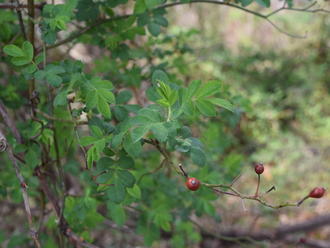Multiflora Rose (Rosa multiflora Thunb.)
↑Summary
A species of rose, native to east Asia, and widely introduced to North America, where it is typically considered an invasive species. Named for the fact that it has clusters of many flowers.
↑Range - Expand
| Legend | Color |
| Introduced | |
| Introduced or Not Present |
This tentative map is based on our own research. It may have limited data on Canada and/or Mexico, and there is some subjectivity in our assignment of plants as introduced vs. expanded. Read more in this blog post.
Although this plant occurs somewhere in each of these regions, it may only occur in a small part of some or all of them.
↑Control
This species, although widely established and persistent on sites where it occurs, is relatively easy to control manually. It tends to form large thickets with arching canes which root in patches of fertile soil. Pruning or lopping shears can be used to cut plants back to within a few inches of the ground, then a shovel or uprooting tool can be used to dig out the main root system.
Although plants can resprout vigorously from the root crown if top-killed, they cannot resprout from smaller pieces of side roots. Thus separating out the central piece of root under the root crown is sufficient to kill each portion of the plant where it has rooted. Canes will usually only root if attached to a parent root system, so once the plants have been severed into separate root crowns and canes, they can be left in place to die.
Mowing is not usually effective. Repeated mowing tends to kill multiflora rose, but its thorns can cause flat tires on lawnmowers with air-inflated tires. Filling tires with foam can get around this limitation. However, mowing is usually a poor way to control this plant because typically, 3-6 cuttings over a 2-4 year period are necessary to completely kill plants, and this will eliminate most desireable native species from most sites as well, and may facilitate the spread of other invasive plants as in most regions, there are more non-native species than native ones that can survive on frequently-mowed sites. Another problem with mowing is that multiflora rose tends to occur on forest edges, and mowing the edge will increase light penetration deeper into the forest, thus causing the multiflora rose to spread further into the forest.
On sites where severing and digging out the root crown is too much work or would have a negative impact through soil disturbance, cutting can be followed by painting or spraying herbicide onto the stump. This approach is best carried out during the dormant season to minimize the effect on non-target species. Multiflora rose is known to be vulnerable in this way to many herbicides, including glyphosate, picloram, and triclopyr. Of these, triclopyr and picloram may be more likely to cause harm to non-target species because it can be absorbed through the ground, whereas glyphosate tends not to.
Foliar sprays can also kill multiflora rose when applied during the growing season, but this approach is much more likely to cause harm to non-target species and is thus best avoided except in the case that there is a large area where no desireable species are growing. Multiflora rose is known to be vulnerable to glyphosate, fosamine, and dicamba as foliar sprays.
Although it spreads by seed, such spread is slow, seedlings are uncommon even where this plant is abundant, and their growth and establishment is slow. The massive extent of this plant in Eastern North America is more a function of the fact that it was widely planted by humans for years, than anything else.
The relationship of fire to multiflora rose has not been as extensively studied as that of some other species, but preliminary evidence suggests that this species is poorly-adapted to fire. Fire usually top-kills plants, leading it to resprout from its root system, but because this species invests a lot in above-ground growth, fire tends to stress plants and deplete their energy reserves. This contrasts with a number of native roses which are more fire-adapted. Prescribed burns can thus kill it after several seasons, as well as hindering its spread into an area. Burning is a good choice in habitats that can be burned safely, that would burn naturally, where native plants are fire-adapted, and where there are other invasive plants that can be controlled by fire.
It is also important to cease and avoid management practices that unintentionally promote multiflora rose. The clearing of timber along the edge of a mature forest is particularly damaging as it opens up a lot of edge habitat where light penetrates deeper into the forest interior than it normally would along an edge, and this happens because the trees adjacent to the cleared area lack lower branches. One of the driving factors of this type of clearing is road widening, which creates such wide edges over a long distance and thus creates massive swaths of habitat ideal for this species. Another factor is the pruning off of low branches along the edges of paths and roadsides, which has the same effect. Leaving branches intact the whole way to the ground, along a forest edge, will not completely eliminate multiflora rose but it will limit its survival to a narrow strip along the edge, which can make it much cheaper and more feasible to completely eliminate it.
↑Links & External Resources
• Multiflora Rose | Fire Effects Information System (FEIS) (About This Site)
• Rosa multiflora (Multiflora Rose) | Illinois Wildflowers (About This Site)
• Rosa multiflora (Multiflora Rose) | USDA PLANTS Database (About This Site)
• Rosa multiflora | Go Botany (About This Site)
• Rosa multiflora (Multiflora Rose) | Missouri Botanical Garden Plant Finder (About This Site)
• Multiflora Rose | Virginia Tech Dendrology Factsheets (About This Site)
• Rosa multiflora | Biota of North America Project (BONAP) (About This Site)
• Rosa multiflora | NatureServe Explorer (About This Site)
• Rosa multiflora | Flora of North America (About This Site)
• Rosa multiflora | Missouri Plants (About This Site)
• Multiflora Rose | Maryland Biodiversity Project (About This Site)
• Rosa multiflora Thunb. ex Murr. (Multiflora Rose) | Digital Atlas of the Virginia Flora (About This Site)






